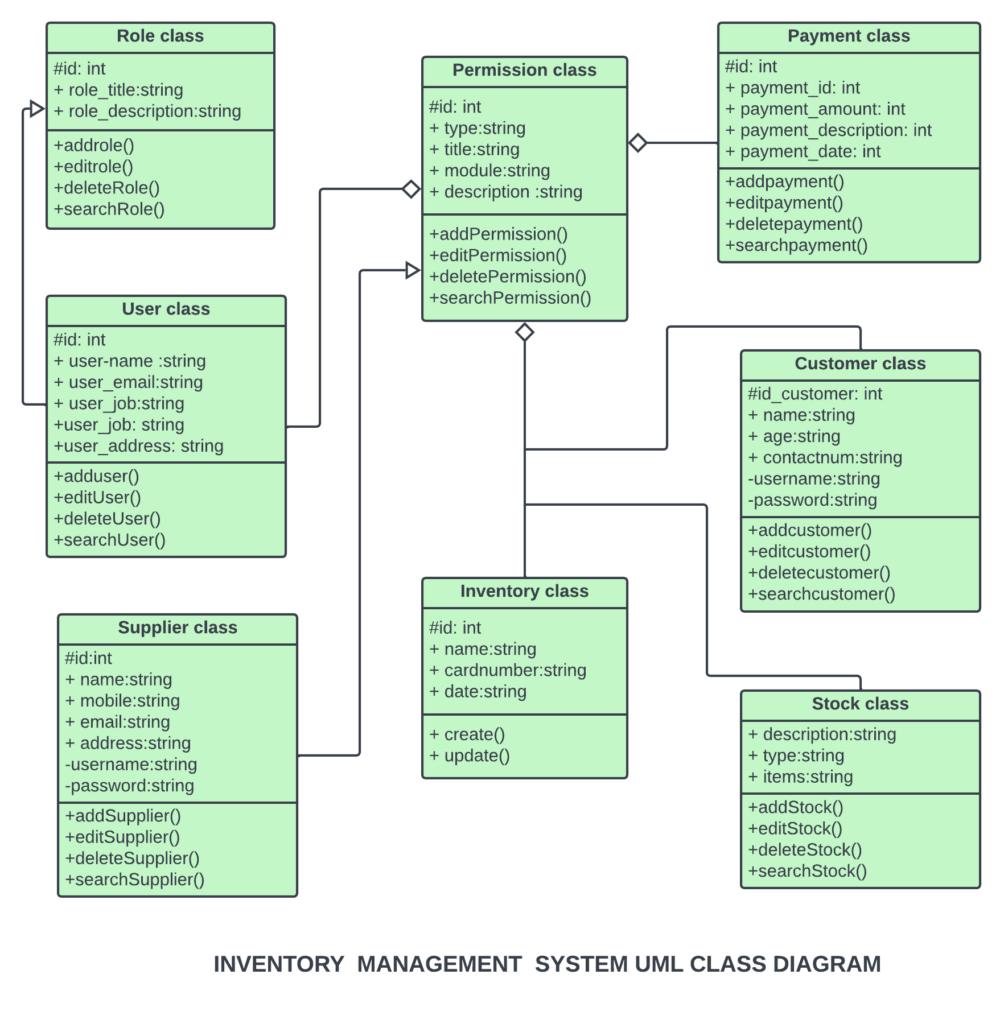The Class Diagram Inventory Management System is a picture that was made to show the classes, relationships, and classes of the projects.
This UML Class Diagram is made to help programmers with the development of the Inventory Management System. It has the class’s attributes, methods, and how the classes relate to each other.
The mentioned content makes sure that the development of your inventory management system is in line with what it should do.
A UML class diagram is very important when making inventory management. This is because the class diagrams are very good at showing the structure of the system, including how each class is put together.
What is a class diagram of the Inventory Management System?
Class diagrams show how your system or subsystem is put together. Moreover, you can use class diagrams to model the objects that make up the system, show how the objects relate to each other, and explain what the objects do and what services they offer. Finally, class diagrams are useful at many points in the process of making a system.
The class diagram is presented in a rectangle with three partitions. Then, the upper part is for the name of the class, the middle is for its attributes and the bottom is for the methods. These partitions will clearly emphasize the details of the classes.
What is Inventory Management System Class Diagram
The Inventory Management System Class Diagram shows how the system will handle the different types of information or data.
Classes will stand for these pieces of data or information. Each class will have its own properties that match the methods it will use. So, the UML Class diagram shown by a box with three parts.
The name of the class was in the top part, the attributes were in the middle, and the methods were at the bottom. The arrows on them show how they are related to one another.
Inventory Management System Class Diagram shows how a system’s classes are put together, as well as their properties, operations (or methods), and how they relate to each other.
Inventory, Customer, Purchasing, Stock, Payment, and Supplier are the main types of the Inventory Management System.
How to Create a Class Diagram Inventory Management System
Time needed: 3 minutes
Here, I will be showing you the Steps on How to Create an Inventory Management System Class Diagram. It was provided with its attributes with matching methods.
- Step 1: Identify the class names
The first step is to identify the primary objects of the system.
So the classes that are included in Inventory Management would be the role, permission, payment or supplier, inventory, and stock. - Step 2: Identify relationships
The next step is to figure out how each class or object is linked to the others. Look for things they all have in common and things that make them different. Lastly, this will help you group them together when drawing the class diagram.
- Step 3: Create the Structure
First, add the names of the classes and connect them using the right connectors. Attributes and functions/methods/operations can be added later.
The following are the access levels and the symbols that correlate to them:
Public (+)
Private (-)
Derived (/)
Protected (#)
Static (underlined)
Package (~)
UML Class Diagram for Inventory Management System Example
The Inventory Management System’s Class Diagram UML is a modeled diagram that shows how its classes and relationships work.
The diagram shows the names of the classes and their attributes, as well as their links and methods. It is the most important type of UML diagram, which is important for making software.
It’s a way to show the structure of the system in detail, including its properties and how it works.

Examine the Class Diagram Inventory Management System symbols in the diagram that show how visible something is.
These are significant because they inform your Class Diagram about the status of an attribute. Some of the Class’s attributes are public (+), which means that they can be accessed by the classes that are connected to them.
The (#) symbol indicates that only the same class or subclass has access to the data’s attributes, whereas the (-) symbol indicates that no other class has access to the data.
Conclusion:
You need to know how the Inventory Management System is designed and built using diagrams.
That’s because you can’t make a system that works perfectly without it.
But if you make this class diagram, you’ll know what classes and situations the system should be able to handle.
You will also find the necessary processes and link them to the other UML Diagrams.
Then you need a diagram to show the classes that are needed to get the result you want.
It is also used to model the system’s parts, show how they work together, and explain what each object does and what services it provides.
Related Articles
- Class Diagram for Library Management System
- Class Diagram for Online Shopping
- ATM System Class Diagram
- Class Diagram for Railway Reservation System
- Class Diagram Hotel Management System
Inquiries
If you have inquiries or suggestions about the Class Diagram for Inventory Management System just leave us your comments below. We would be glad to hear your concerns and suggestions and be part of your learning.
Keep us updated and Good day!
